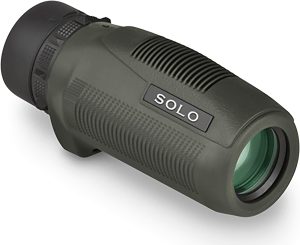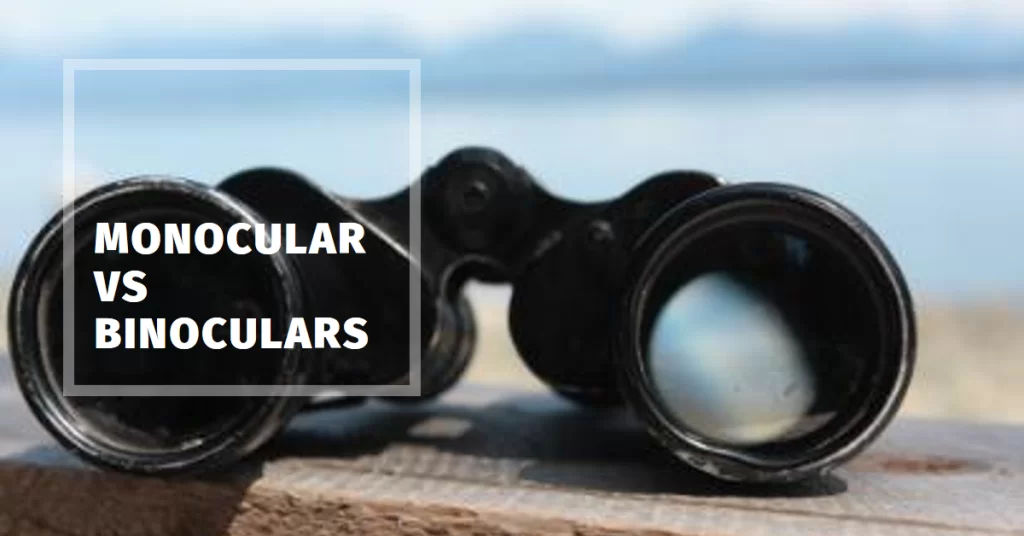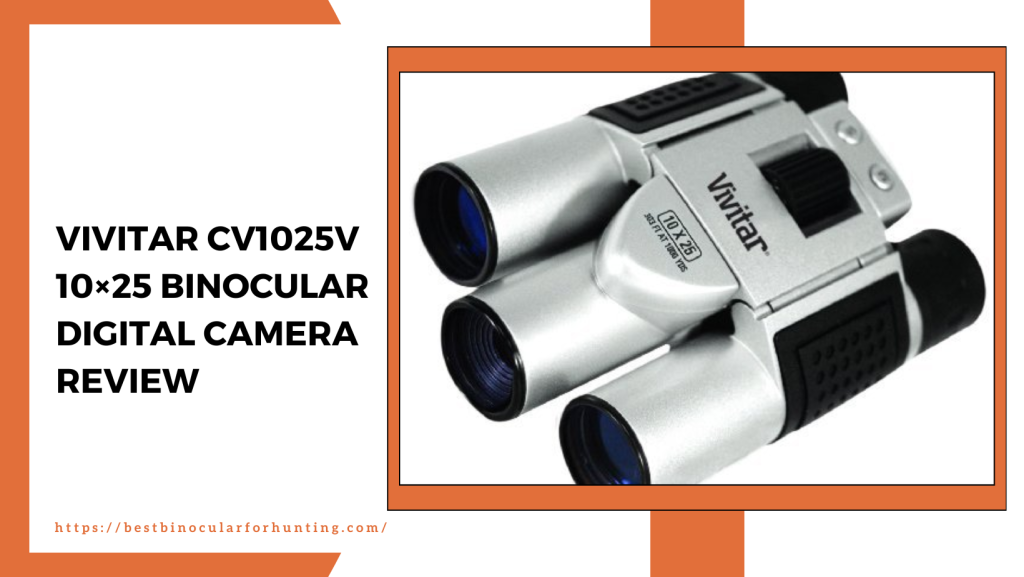For nature viewing, hunting, boating, or other optics applications, consumers often debate buying a monocular versus traditional binoculars. While these tools serve similar purposes of magnifying distant objects, they differ in a few key ways that impact usability.
Understanding those differences allows matching the proper optical tool with your intended activity. This guide will compare monoculars and binoculars across critical factors like design, specifications, performance, and best use cases.
Whether a compact monocular better serves your needs versus full-sized binos or vice versa becomes clear once you know what sets them apart. Let’s dig in!
Design and Spec Differences
The most obvious variance between monoculars and binoculars manifests in their physical build:
What is a Monocular?

As the name implies, a monocular is a single barrel optic that you view through only one eye. The streamlined tube body resembles a miniature telescope, ranging from pocket models just a few inches long up to larger units over a foot long. Objective lens size typically falls between 21mm to 56mm.
| Pros | Cons |
|---|---|
| – Extreme portability | – Limited field of view |
| – Lower cost | – Better low-light vision |
| – Better low light vision | – Harder to stabilize |
What are Binoculars?

Binoculars connect two monocular tubes with parallel optics into one cohesive visual unit. A center hinge allows adjusting the spacing between ocular lenses to align with the user’s eyes. Standard sizing includes both objective lens diameter (typically 8×42, 10×50, etc) and lens magnification power.
| Pros | Cons |
|---|---|
| – Wider field of view | – Heavier and bulkier than a monocular |
| – Better contrast and clarity | – Typically more expensive |
| – Easier to stabilize | – Lower magnification range |
Beyond physical form, monoculars and binos differ across some key technical specifications:
| Monocular | Binoculars | |
|---|---|---|
| Weight | 1-2 oz range | 15-40+ oz range |
| Magnification | 6x to 12+x zoom | 8x to 10x fixed |
| Lens Size | Objective: 21-56mm | Objective: 32-50+mm |
| Exit Pupil | 2-7mm | 2-7mm |
| Field of View | 20-1000+ yards | 300-1000+ yards |
| Eye Relief | .39” | 15-20mm+ |
| Close Focus | 3-6 feet | 10-20 feet |
Now that you understand the innate design and performance differences, let’s explore ideal use cases more closely.
Monocular vs Binocular Use Cases
With vastly different builds comes tailored utility:
Monocular Use Cases
The compact profile and light carry the weight of monocular suits many applications:
Hunting: Pack one to spot distant games without adding bulk. Single eye allows scanning while keeping peripheral vision open.
Backpacking: Easily pack without weighing down your gear. Pull it out quickly to spot wildlife and terrain details.
Concerts/Events: Peer at a stage or field without lugging full binoculars. Pocket monoculars work nicely.
Boating/Fishing: Pull one out to scout fish or hazards from the deck then tuck away neatly. Doesn’t swing and knock around big binos.
Astronomy: Higher zoom magnification can track stars and celestial bodies better than typical binocular specs.
Racing: Scan grandstands easily and zoom focus on key areas of action during auto/horse racing.
Binocular Use Cases
While heavier and a bit clunky by nature, binoculars offer optical advantages that beat monoculars for:
Birding: The wide lenses and dual view provide better depth and contrast for identifying features quickly.
Hiking: Allows engaged viewing across vistas and spotting details like trail markers better with two-eyed sight.
Concerts/Events/Sightseeing: Again, the wider field of view with both eyes allows for keeping the action in view better from a seat or on the move.
Backpacking/Safari: Two eyes reduce strain during prolonged viewing like scanning the landscape for prolonged periods.
Astronomy: Larger objective lenses capture more light for stargazing clarity; wider FOV is good for comet tracking.
Direct Comparison of Optical Capabilities
Now let’s directly compare some of the optical and viewing performance factors between monocular and binocular formats:
Magnification Power
Winner: Monocular
With compact bodies and simple focusing components, monoculars integrate zoom magnification easily in prism and roof styles reaching 12x power or more. The highest binocular magnification barely reaches 10x due to bulk and weight. For pure magnification capability, monoculars win.
Low Light Ability
Winner: Tie
Larger binocular objective lenses have a slight edge gathering more total light. But monoculars offset some of this thanks to concentrating all light through a single viewing path. Both formats usually share similar exit pupil diameters. In very dark conditions, a large 50+mm objective binocular performs best.
Field of View
Winner: Binoculars
Two barrels placed an appropriate distance apart for human eyes inherently provide a wider field of vision over one narrow tube. This allows for keeping fast action or expansive scenery in view better. Monoculars compensate for some through higher zoom and moving the unit.
Contrast and Clarity
Winner: Binoculars
By merging two image paths instead of one, binoculars average out imperfections providing a slight contrast and sharpness advantage over using just one eye. This benefits in detecting subtle details like songbird plumage patterns. Prisms and anti-reflection coatings offset this difference, however.
Eye Strain and Fatigue
Winner: Binoculars
Using both eyes splits the workload for more comfortable viewing sessions. This allows scanning terrain extensively without as much eyestrain. Over prolonged periods of glassing for games or observing wildlife, binoculars cause less fatigue for most users.
Price
Winner: Monocular
Particularly in compact, basic zoom models, monoculars come significantly cheaper than full-sized binos. Larger high-end spotting monoculars close this gap, but on the whole, monoculars beat equivalent binoculars on price.
Best Uses Summary
To recap, here are the broad strokes on when a monocular versus binoculars works better:
| Monocular | Binoculars | |
|---|---|---|
| Stargazing | ✅ | ❌ |
| Boating/Fishing | ✅ | ❌ |
| Spectator Sports | ✅ | ✅ |
| Weight Sensitive Use | ✅ | ❌ |
| Low Light Use | ✅ | ✅ (with large objective lenses) |
| Field of View | ❌ | ✅ |
| Minimizing Eye Fatigue | ❌ | ✅ |
| Overall Optical Clarity | ❌ | ✅ |
So in summary:
- Favor monoculars when ultra-compact size, light carry weight, and cost are driving factors – particularly for applications like hunting.
- Binoculars provide superior optical performance across critical metrics like field of view, eye relief, and clarity – ideal for birding, safaris, sightseeing, etc.
- For many use cases like spectator sports and boating, either option serves reasonably well.
Final Recommendations
Monocular: Vivreal 12×42
| Price | $39.99 |
| Weight | 7 ounces |
| ED Glass | Yes |
| Lens Coating | Fully multi-coated |
Vivreal’s 12×42 monocular offers extreme optical clarity in a waterproof/fogproof housing weighing just 7 ounces. ED glass corrects for chromatic aberration and 12x power zooms details clearly at distance – perfect for hunting and birding.
Binocular: Bushnell Legacy 10×42
| Price | $149 |
| Weight | 23 ounces |
| ED Glass | No |
| Lens Coating | Fully multi-coated |
The mid-priced Bushnell Legacy model offers fully multi-coated optics and quality prism glass in a durable, waterproof chassis – ideal for birdwatching and safaris. The 10x magnification suits scanning terrain extensively over hours.
For most uses, carefully choose either a quality monocular OR binocular that excels across your critical requirements like size, weight, magnification needs and optical clarity within a set budget.
Don’t assume one inherently beats the other universally. Different optics serve different applications best. Understanding these key differences allows matching your needs with the proper viewing tool.



